|
 |
RSS Feed  |
a playground of art, photos, videos, writing, music, life |
|
|

You are here
|

Creativity!
|

Get it!
|

I like it!
|

Fun stuff!
|

About me...
|
| |
|
|
|
|
Random Quote
If I don't write to empty my mind, I go mad. As to that regular, uninterrupted love of writing...I do not understand it. I feel it as a torture, which I must get rid of, but never as a pleasure. On the contrary, I think composition a great pain.
-- Lord Byron
|
|
|
|
|
|
Blog Posts for April 2005
Home Page
Blog Archive by Month | Blog Archive by Story or Tag | Search Blog and Comments
Jacob and I went for a long walk this morning. I took a bunch of pictures... here are a few...   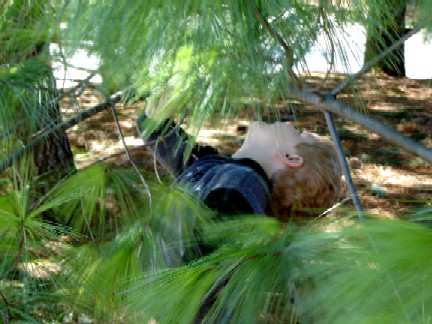      At one point, Jacob shouts to me, "Dad! Did you see that dog in the car?"
I turned in the direction of the sedan, but couldn't see anyone inside. "No, Cub. What kind of dog was it?"
He looks up at me and cocks his head and an eyebrow. "Don't you know?"
"Um, no. I didn't see the dog..."
He sighs and shakes his head. "Dad," he explains, waving his arms to enunciate his point. "All dogs are CANINE." Of course they are :) |
|
|
 I finished the Da Vinci Code. I had been asked by a few people if I had read it. They're familiar with my spiritual journey and know that some of what Dan Brown wrote mirrored some of what I have said in the past. I finished the Da Vinci Code. I had been asked by a few people if I had read it. They're familiar with my spiritual journey and know that some of what Dan Brown wrote mirrored some of what I have said in the past.
Spiritually, I only know/believe one thing these days: God exists. I don't know what God is or what God is all about or how involved God is in our lives, but there is too much order in the universe to deny intelligent design. Anyone who can do that can do, well, whatever they like. I just can't believe that my 4-pound brain can grasp the nature of that being. If others know the truth more authoratatively than I do and believe more confidently, I envy them. I don't personally assert my questions and doubts upon others unless pointedly asked. In a conversation, I'm more inclined to tell a Christian supportive chapter and verse than anything else. That said, here are my thoughts on the Da Vinci Code... Obviously, Mr. Brown spent a lot of time reseaching and creating the plot and puzzles. The facts that he cites of early church history are pretty close to what I know to be true. My understanding from several sources is that Constantine's Council of Nicea was a political, not a spiritual, event. Afterward, his government killed people who believed other than what was declared to be true and so history and doctrine were cemented for centuries. Dan Brown is also right that there are a plethora of other gospels than just Matthew, Mark, Luke, and John. Thomas, Philip, and so on all wrote about their experiences. But these weren't included in what we know as the Bible. Why? Beats me, but the committee didn't want to include them. The whole Jesus married Mary thing... I don't know. For my spiritual life, it doesn't matter. I don't think I'll research it further for that reason. But any book that causes churches to fight it as hard as they do, well that's just great marketing. Just as people were fighting Mel Gibson for his pretty much straight-from-the-bible film, Passion, which helped boost the buzz around it. (Great film, by the way. Very accurate to the text of the bible, which is partially why it sold as well as it did.) Great book, but it's just a book. It shouldn't determine faith. |
|
|
Here's Jacob's artistic contribution to a wonderful day. 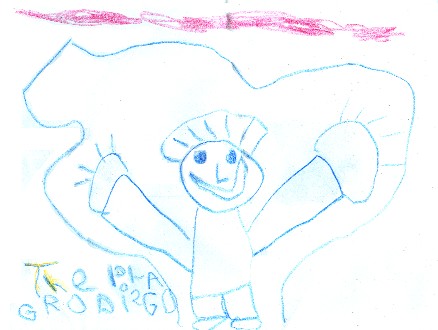 I love my son. He drew this after our walk today and our playing on the playground. He's right; "THE PLAYGROUND IS GOOD." Unfortunately, he ran out of room for the word, "good." |
|
|
About a week and a half ago, I took my bike to the shop for its spring tune-up. It needed it big time. I haven't ridden since I fell off my bike in December, so I've been quite anxious to get back on. My herniated back is better and even though I broke my foot, it's bearable - I'm just tired of being immobile. I picked up the steed at 6 PM and had to wait until later tonight for a ride. I videotaped it. Click on the picture to take a look at about a minute and a half of the ride.  What you see in the video (done with my little Cybershot) is part of my route to work in the mornings, which I will begin again now. I ride down a sidewalk, the video goes black for just a bit as I negotiate a U-turn waiting for a passing motorcycle, and I move into the parking lot of a building with a mid-section that actually looks like R2D2. It's about halfway to work. The breeze was lovely. The bike in tip-top shape. And the freedom to be moving again on my bike is wonderful. What a great night :) |
|
|
I haven't been posting much for the past couple of days because life kind of grabbed me and didn't let go. On a positive note, my son, Austin, celebrated his 8th birthday. Which was a week ago, actually, but the party was last night. Friends and family and gifts and laughter. Great medicine for what preceded the night. Work has been very, very busy for me. I don't usually "work blog," but we were trying to get some things wrapped up for a group and scheduling was tight. And a couple of the web sites that I've developed for departments look like they might go corporate, which is exciting. And I've been asked to write an Intranet search engine, so I've been trying to wrap my brain around that. I know a decent amount about how Google works, so I'm using what I know to be best practice to do this. It's a cool puzzle to solve. And my daughter has had to deal with the suicide of a friend of hers. We found out two nights ago and have been reeling from it since that time. The greater tragedy in the death was that the girl didn't actually intend to kill herself. She just wanted time away from everything and was hoping for a hospital visit of a few days. Unfortunately, the overdose of anti-depressants took over and the ambulance arrived to late to save her. She made it to the hospital, but it was there that she woke up long enough to apologize to her parents. And then she died. My daughter's best friend called me at work to tell me of the news. I went home to then break the news. As I've watched her come through this, I'm deeply proud of her and thankful for who she is. I listened yesterday at work to Bonnie Raitt's "Wounded Heart."
Wounded heart, I cannot save you from yourself
Though I wanted to be brave It never helped
Cuz your trouble's like a flood raging through your veins
No amount of love's enough to end the pain
It was about all I could do to keep from crying at my desk. I mean, you can't help but think of the trauma in your children's lives and what they go through and I just sat awash in gratitude that I know each of them. I go home each day and make dinner for the older three and myself. One of them once told me that I am their anchor in the world. I think it's easy to take little things for granted. Like dinner with people you love.A friend of mine sent me some quotes this morning, one of which was this:
And in the end, it's not the years in your life that count. It's the life in your years.
--Abraham Lincoln
On the night that she found out, my daughter drove to where the girl lived and spent time with all their friends. They each took turns telling their favorite stories about her. Like the time that she died her hair blue, or the time that she drove the car while a friend rode in the trunk to see what it was like. They reminisced about her artwork, which was very good, and about her honesty, which was always direct but kind.Though I appreciate Lincoln's thought about quality over quantity, quantity is not to be disregarded. "Love" is spelled "T-I-M-E." So spend time with those you love this weekend, and don't forget to tell them how they matter to your life.
|
|
|
I bought Richard Schmid's book, "Alla Prima." Easily the best book on the making of art that I've read. Conversational in its tone and deep in its treatment of art, truly a treasure from a man who loves making art. I want to quote his discussion of drawing. It's everything that I would want to say, but he says it far better and with more authority. Emphasis in bold is mine... Enjoy :) There is a popular notion that artists are born with an ability to draw, but that isn't true. The impulse to draw is there, but no one arrives in this world endowed with the capacity to graphically depict visual reality. I have never known a painter who was just "naturally" good at it and could do it without serious training. Drawing is a skill that must be learned, but it isn't like swimming or riding a bike. Once you get the knack of it, you can't relax and just let it happen by itself. It takes constant practice and presence of mind. Why? Because it is not a physical skill; it is a mental discipline. It deals with continual variables rather than the repetition of memorized shapes. I always have the fond hope that someday it will get easier, but it never does. Sound drawing always demands great care right down to the last dab of paint.For most of us, the word "drawing" brings to mind an outline of something. This deeply ingrained assumption originates in childhood when we learned to use lines to make pictures. Yet in real life there are no lines around things. Line drawing is only a representation or diagram of our visual world. Painting, on the other hand (the kind I am dealing with here), attempts to create an illusion of that world. Consequently, in this discussion when I use the word "drawing," I mean the size, shape, and arrangement of all the patches of colors that collectively make things look the way they do (and which also constitutes a painting). When you render those patches the right size, the right shape, and with their distinctive edges and color, your painting will look like your subject. If you don't - it won't. It will look different. Drawing is simply measuring. As it applies to direct painting from life, drawing comes down to nothing more than figuring out the width and height of color shapes and then fitting them together. Still, drawing remains very difficult for nearly everyone, which is odd when you think about it because drawing is only the visual element we work with that seems to deal with a measurable and definable aspect of the visual world. The other three elements: color, value, and edges, are relative qualities with generous room for interpretation. Drawing is about specific dimensions. That, folks, is a masterful explanation of drawing. And if you like painting, or want to paint, buy the book. It's cheaper and available in soft copy at his web site, which is where I bought it. |
|
|
Take a look at the following image:  Could you draw that? I suspect that just about anyone could draw a line that looked reasonably similar to it. How about this one?  A little more difficult, but I still believe that almost anyone could come very close to drawing lines that looked like these. Now here's the thing - these are taken from a larger picture that I've broken up into squares. This is the entire composite: 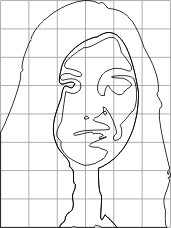 If I removed the grid, it might seem harder to you to freehand draw it. But broken into a grid, it appears much easier. In fact, I suspect that if I left the grid in place, most people would see their way to a step-by-step, or should I say square-by-square, approach to draw this woman. If I had started by asking you to draw the woman shown below, and you didn't believe that you had any skill in drawing, you might have balked. 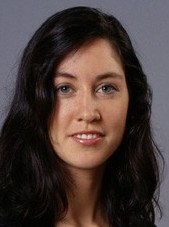 But if you know of a method that allows you to get there, line by line and step by step, you could then believe it. Here she is "painted," or colored in from the wireframe squares image shown above.  If you had painted such a picture of her, how would you feel about your talent? Painting isn't about talent. It's about knowing the process and then doing it. It's my opinion that anyone can draw and/or paint. Those who wish they could but don't think that they can just need to know how. |
|
|
Drawing with a pencil is much harder, in my opinion, than drawing with paint. With paint, I can choose the shades of colors to represent darker areas. Green looks like green and red looks like red. Not so with pencil. Pencil is a gray world. And you can't fill an area with pencil like you can paint. Pencil is also a world of lines. Fat lines, maybe, if you lay the pencil's tip on its side, but it's still lines. Drawing is the root of all painting, and so practice is important. For me, it feels like exercise first thing in the morning. I get up, I don't want to do it, but I know it's good for me. I mentioned that last night I drew while at the playground with Jacob. Here's what I drew:  My scanner muddies this up a bit, but you get the idea. And here's the actual picture:  When I draw from a photo, it's much easier to "measure," or compare distances. But it's much tougher when viewing it live. You can see how I skewed the bench, in particular the bench on the right. Where did those curves come from? Trees give me fits. So much texture and complex shading... how do you do that with a pencil in a sketch and make it look real? More good practice. So today, Cub and I went back to the playground. After playing for a while, I went back to the bench and started to sketch this tree: 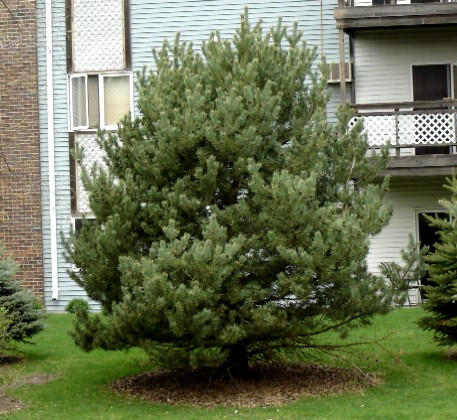 And here was what I did:  I'm not happy with it, but again, it's all good practice. For what it's worth, if you enjoyed the bike ride video last week, here's another one, which is a short ride through my apartment complex. I came home from my little bike ride and found my son and his girlfriend playing their new favorite game together, Boggle. They had this layout: 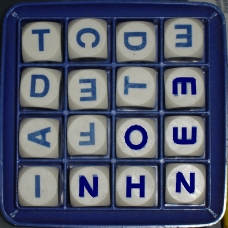 Boggle is a great game. The key to big points is how you look for suffixes and prefixes that lead to larger words. They're learning this, but with this layout, they only managed a few 5-letter words and the rest were smaller. New to the game, they couldn't see these two 6-letter words: 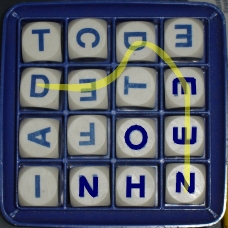 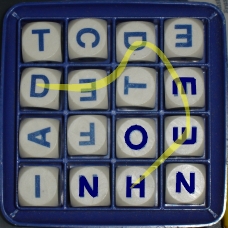 The more I think about it, the more it seems to me that how we see things is the key to success, whether it be painting or management or Boggle - whatever. The techniques, once known to us, don't really require great skill of any kind that we don't already have, but simply practice in how to see things in a way that helps us to our goal. It's a good Sunday... |
|
|
It's awfully gray here in Iowa. Rain has settled in and while I appreciate the rain for what it does to plants, here's my protest picture: 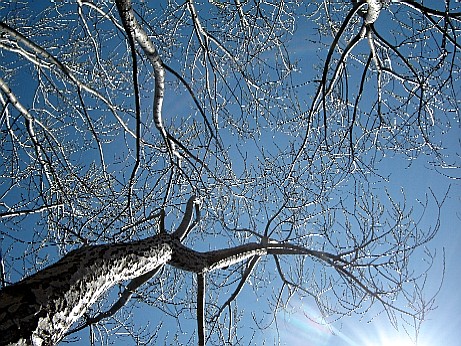 |
|
|
 | Drawing: Examples of the Grid |  |
The other day, I mentioned a gridded approach to drawing that helps to ensure accuracy and provides a method that just about anyone can follow. If you're getting started and you don't think you can draw, a grid can make it easy. And even if you're not getting started, you're in good company if you use such a system, as I'll show here.  This was done by Albrecht Durer, and it's called "Draughtsman making a perspective Drawing of a Woman." He shows a wireframe window through which he views the subject of the drawing. The grid allows him to get the proportions correct as he draws the outline of the figure. This was done in 1525. A college math major did a paper that linked math to art. They said this: Alberti is known for introducing the approach of using drafting lines to create grids to guide the creation of life-like perspective and proportion. Leonardo Da Vinci worked on an instrument he called a "trellis work" that assisted artists in placing subjects realistically in conjunction with each other and relative perspective. In Germany, an artist named Albrecht Durer, worked with a method of transferring small drawings accurately to larger sizes using his grid system. Grids are still in use. Here's a wonderful example: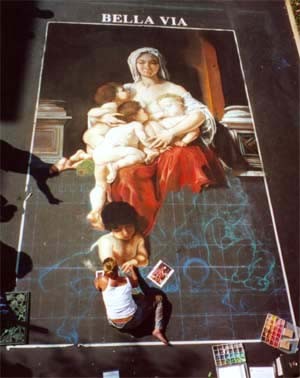 You can clearly see the chalked grid in the unfinished part of the street painter's work. Notice in particular the outline of the child curled up on the lower right. Let's take a closer look. 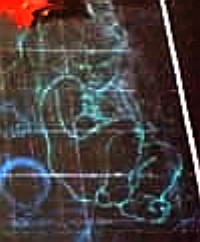 Now just look at the individual squares. I'll enhance it to help with that. 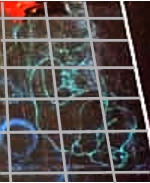 Broken down to the square and early chalk outline, this beautiful work of art doesn't seem so impossible to do. If you can use such a system to get the proportions correct, and if you can select colors, then you can most likely paint. I hope this thread on drawing helps to spark some possibilities for those who would hesitate to try their hand at art. It's just a matter of knowing the right steps to getting there. |
|
|
|
|
The Visual Equivalent of Headphones |
I'm currently listening to one of the most profound songs that I know, which is the 2001 version of Joni Mitchell's "Both Sides Now." Not her original, but the one that she did with full orchestra behind her. I'm lucky... as a programmer by trade, I get to listen - pretty much uninterrupted - to music through my headphones for hours every day. I'd been using little earbuds lately, but yesterday I switched back to my big, head-engulfing Aiwa headphones and the sound quality is supreme. It's the difference between looking at pictures of the Bahamas and actually being in the warm sand and clear water of the Bahamas. If you compare listening through normal speakers and listening through earbuds and then listening through high quality headphones, headphones win. By far. You can hear the musicians' subtleties, the ambient hollow in the faint echo of a drum... It's stunning. It's more. It makes me love music to where I crave it that experience again and again. If headphones escalate the music experience that I have, then what's the equivalent for art? Most of us view art casually, much like most people listen to music. Were it not for the isolated position that I have as a programmer, I'd be one of those people. Prior to last December, art wasn't important to me. I didn't crave it. Pleasant, but non-essential. Not so today. Having painted and lived through the re-assembly of color and form, I know it more now. While one doesn't have to be making the music to appreciate it more, one shouldn't have to be a painter to have a heightened experience of art. So what is the visual equivalent of headphones? As I sit and think about it, I think it's actually owning the piece, in full-scale reproduction or print, and being able to be alone with it, in isolation, to look at it and consider it. We all own hundreds, or even thousands, of songs. But we own so little art. Is that because songs are 99¢ each and art is, well, at least a $20 purchase at Wal-Mart or $hundreds from a private atrist or gallery? I know that Bill Gates' home has large, flat-panel screens that displays works from his collection. I know also that some companies are trying to get consumers to purchase art in bulk for display on their plasma screens at home. Seems to me like like there's an opportunity here for indpendent artists... much like MP3's made it available for independent musicians to release their music to the world without music companies. |
|
|
Doug has a most excellent post about the current hullaballo over Tom Delay. Good stuff. I say the answer is to dispense with the notion of "public servant for life." I was never for term limits in the past, but I'm getting there fast. (I tend to vote Republican, so my beef is not with Mr. Delay personally, but with the way that Congress is set up in the first place. Doug goes into the workings of Congress nicely... go read it.) |
|
|
I mentioned the other day that I've been tasked at work to build an Intranet search engine. We have a lot of departments in Wells Fargo, where I work as a consultant, and I build database-driven web sites for them. A department came to my group recently and said that they needed a search engine for the nearly 100 PDF's that they have on their Intranet site. Small task, but I knew that if we built it right, other groups would ask for the same thing. We delivered the prototype and others are lining up. Very cool. Lots of thought goes into a project like this. Given a cool puzzle, I find my head turning it around in my off-hours as well. What goes into a search engine? First, because we're talking about myriad and large PDF's, I need to convert the PDF's to text because the PDF file itself looks like this: ÈÍj?ãû&ÈçÇCOÕ5Õë¹Aá; It's not searchable unless you're in Adobe Acrobat and viewing the document. I found a little conversion tool at VeryPDF. It does batch conversions, so first problem solved.With the text in hand, it's time to consider how people search. Take this sentence, for example: The Home Mortgage Assessment Program(TM), developed by Judy Edwards, addresses the needs of all borrowers and co-borrowers alike. It can't be built to just store all of the text and then allow for phrase searches only. If so, and the user knew it was a mortgage program of some sort and typed in "mortgage program," they'd miss it because the actual phrase is "Mortgage Assessment Program." So it has to be by word.Simple search engines on some web sites just store all of the words in a document into a big table of words and then return everything with either "mortgage" or "program" in it - not necessarily demanding that both are in it. So the user could be browsing documents with only the word "mortgage" in them and not "program." That's annoying, and wasteful of the user's time. Next, the words themselves. Take the word "Program" in my example sentence. It's not just "Program" - it's "Program(TM)." So the words have to be analyzed and reduced to their true intent. Further, the database will return results faster with exact match searches and not wildcard searches. English is a good mountain to climb with that goal in mind. Let's say that a user types "short-term loans" into the search engine. Will all documents have "short-term" hypehnated? Probably not. And even though they typed in "loans," they'll want to find hits for "loan" as well. Today, I find myself researching grammar rules pluralization and rules for possessive nouns so that the engine can "de-plural" words so that users can get the best search results possible. Rule #1
The plural of nouns is usually formed by adding - s to a singular noun.Rule #2
Nouns ending in s, z, x, sh, and ch form the plural by adding - es. Rule #3
Nouns ending in - y preceded by a consonant is formed into a plural by changing - y to - ies. Rule #4
Nouns ending in y preceded by a vowel form their plurals by adding - s. Rule #5
Most nouns ending in o preceded by a consonant is formed into a plural by adding - es. Rule #6
Some nouns ending in f or fe are made plural by changing f or fe to - ves. In my geeky way, I love this project.Tuesday, I researched the 1,000 most common words in English and the search engine won't be indexing prepositions, adverbs, articles, conjunctions, and words like those. And at the moment, I'm studying names... such as "Wells," like in "Wells Fargo." Here are some common names: SMITH
JOHNSON
WILLIAMS
JONES
BROWN
DAVIS
MILLER
WILSON
MOORE
TAYLOR
ANDERSON
THOMAS
JACKSON
WHITE
HARRIS
MARTIN
THOMPSON
GARCIA
MARTINEZ If I de-plural normal words, I have to be careful not to de-plural names, such as Williams or Davis or Thomas or Jones, which end in -s.Once the words ae broken down and indexed, it's time to create the search engine results given to the user. How do you decide which document gets listed at the top of the results? If I have a document in front of me, I know what's most important to it by what appears first. The main idea is generally given first and then repeated throughout the document. So I'm giving a weight to the words in a document in their order of appearance. If the word "loan" appears 8 times in the upper half of a document, but appears 12 times in only the last part of another document, the first document will get listed first. Further, people will want to see the context of their search words in the matching documents. So I plan to grab 50 words to the right and 50 words to the left of the first occurence of the word and display that, much like Google does. I love puzzles like these. I released a prototype yesterday that had everything but the de-pluralization and users are beating up on it. Good response thus far. We'll see how the finished product turns out. ETC: Found a cool word search engine that does pattern matching, so if you like crossword puzzles and a word is giving you a fit, go here. Do the "Common words only" search. I was using it to find every plural "*ves" word that came from a singular "*f" word. Found them all! |
|
|
Alright You Wordsmiths... |
I wrote my de-pluralization routine today, and I've decided to put it online here. See if you can beat it. Give the engine a plural word and see if it can come back with the right singular form. If it can't, let me know in the comments - and then gloat a lot. Here's the engine. |
|
|
| | | | |
For a while now, I've been wanting to set up beatcanvas so that each article can have its own look. Well, here it is. So far, this crazy border, the "space" look, the "mask" look, the left-side "square" pattern, and the "flowers" look. Just scroll down and you'll see what I mean. I'll be creating more, and then later, I'll let you folks change them. |
| | | | | |
|
|
Recently, Kris (of Anywhere But Here) recommended to me that I use Arches watercolor paper. I'm new to painting, so I hadn't really heard of them before she mentioned them. I went to Michael's, a local craft store, and they had a sale on their Arches 140# pads - buy one, get one free. I took the remaining six pads. But I couldn't find larger paper than these 9" x 12" pads, and Kris suggested that I buy from the Internet because the paper would be unfingered by shoppers. So I hopped online and found Mister Art. I ordered a few more tubes of watercolor and not only was it cheaper than the stores (even with shipping!), it was also fast. So a few days ago I ordered 18" x 24" Arches 140# paper from Mister Art. I got my order today. I'm very impressed by this online store. If you need to buy art supplies, they get my big thumbs up. |
|
|
 | If You Liked That Bit Of Fun... |  |
I was surprised to have the response that I did to my de-pluralizer. A few people said that they enjoy that sort of thing, so I've created an online word game for you here at beatcanvas.com. Here's how it works... beatcanvas.com has a list of 3,777 5-letter words from which to choose. It chooses one of them. You have to guess it by using other 5-letter words. The web site will compare your word against the beatcanvas.com word and then score it for you, by telling you how many letters you have guessed right, and of those, how many are in the right place within the word. So for example, if the beatcanvas.com word was "LLAMA" and you guessed "LEMON," then you would have 2 letters right (L-M) and 1 in the right place, or 2-1. Want to play? Go here... you'll be able to go right to it in the future by clicking on "Play a Word Game" in the menu at left. It's little things like these that are the reason I wrote my own blogger instead of using Blogger itself or Typepad. |
|
|
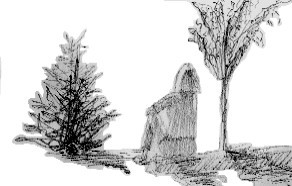 The boys and I went to a park today. Twice. The first time, Jacob had his old three-wheeling bike. Time for an upgrade - so we went to target and bought a two-wheeler. He'll be my last child to learn bicycling from me. Sigh... But when we went to the park, I took my sketchbook with me. A woman and her family were at the playground, and I did a fast rough sketch of her and the two trees that bookended her. I've come to believe that sketching is vital to my art. I need to practice, every day if possible. Earlier in the day, Cub and Nick and I went to Barnes & Nobles and I bought The Ultimate Book of Sketching. It's out of print, but B & N had four copies of it. It's a decent book, not so much on method, but for all of the examples the artists display. I've finished Richard Schmid's book on painting. Truly great book. I've tried my hand at painting and I've never had any formal training, so I've been reading voraciously to give me as much of the essence of it as I can muster on my own. Major influences so far would be Schmid, a watercolorist named David Becker, and Betty Edwards, who wrote Drawing on the Right Side of the Brain and her book on color. The good thing about the three of them is how much they disagree with each other. Becker's watercolors are effortless. He's what I would term a natural artist. Obviously, his "natural" ability is well-honed and practiced. He's a huge advicate of sketching and believes deeply in using initial sketches as a blueprint for composition and values (depth of darkness/brightness). He's unafraid to change a picture to get a better composition. He'll add people, change buildings, and completely ignore the picture's original colors to arrive at what he feels is the best and most interesting painting. Then there's Schmid, whose method is Alla Prima, or paint what you see in one sitting. He doesn't change colors. He paints it as it is, and he's quite ardent about that. Schmid's theory about color is to find a pallete that is true and then learn to blend the colors. He has a fantastic color chart near the end of the book that show how the colors of his pallette blend with each other, and he insists that everyone do this. I see wisdom in this and I'll be doing that myself in the next week or two. He goes into some depth about form (the shape of objects), value (the shading of objects), colors, and edges (the way in which colors and forms meet each other in a painting). Schmid's compositions are fairly straightforward - the subject of the painting is generally at the center and not surrounded by much else. He emphasizes the skill of drawing, like Becker. But he couldn't disagree more with Becker and Edwards about color. Becker and Edwards talk about color harmony. Becker's favorite three colors are purple, green, and yellow-orange; you see them prominently in just about every painting he does. Edwards spends a great deal of time in her book on color discussing how we naturally see harmony in certain colors. Schmid says that's all bullshit. He believes that lighting forces everything into a harmony of sorts. For example, moonlight will blend everything into a pleasant harmony under its spectrum. Sunlight, same thing. I like both perspectives on the subject. I'm too new at this to really have an opinion yet, but again, I'm busy fact-gathering to be as effective as I can be. Where Schmid really differs with the other two is on the topic of edges, and you can really see this in his paintings as well. I've browsed a lot of art books in trying to find ones that would help me understand better and enhance my work to bring out best what it is that I can do. Schmid's comprehensive treatment of edges is unique. Even he says as much in his book. Becker goes into edges a little in one book that I have, but I think watercolors are meant to blend more so that oil can. So are edges in watercolor not as important? I don't know. I do know that Schmid's work is amazing for what it achieves. The idea that he does his paintings, in oil, in a day knocks my socks off. So I've been thinking about all of this. My version of art training... and now my book on sketching to browse and keep me motivated. 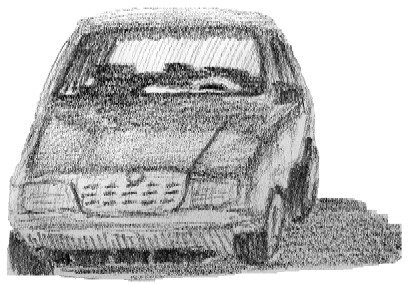 I have noticed that drawing from life is much harder than drawing from a photo. The photo comes with measurable sides and it's easier to get a sense of the shapes. Real life is much more difficult. Here again, this is Schmid's forte. His subjects sit in front of him, whether a landscape or a person. That's brave, in my opinion. So I'm convinced that I need to skecth from real life more often. The preceding sketch is of a car in a parking lot near where I live. Did I capture it? I don't know - I don't think it really matters. It's like a friend of mine likes to say, it's not success or failure that defines us but the journey. Now it's time to make dinner on this gorgeous day :) |
|
|
 I bought a 175g frisbee today. Nick and I were living it up big time. |
|
|
My Sister, the Marathoner |
My sister ran in the Boston Marathon yesterday and finished in about 4 hours.  She's just amazing. |
|
|
I've been home this morning with my son, Nick, who's had a reaction to the tetanus booster that he received yesterday. His throat constricted a bit, but he could breathe and swallow (although uncomfortably), so I've been watching him. He seems better now. While home, I decided to weed out the watercolor tubes that I have for what I want in my essential palette of colors. Schmid's book was very instrumental in this, not so much for color selection but for the idea that it is important to do this. Then I can later mix each color with another to see that it's what I need and what it produces. So here it is:  I initially bought Winsor & Newton's Cotman line of paints, but they're not only a bit streaky, the lids for the tubes are horrible and ill-fitting. I sent an email to Winsor & Newton about it and never heard back from them, so in the strongest manner I can, I dissuade anyone from purchasing Winsor & Newton or Cotman. I'm using Grumbacher Academy paints and I'm happy with those. Smooth, and the Grumbacher Red is the truest red that I've found. And the lids are lovely! So, since Nick is better, I'm off to take him to school and me to work. Hopefully sometime this week, I'll get back to painting. Sketching is cool and necessary practice, but I like colors. |
|
|
Lots of things going on in my personal life, and so I'm up late trying to accomplish one thing that I wanted to do today, which was to work on my palette color selection and mix some paint. I've learned from reading and from practice that it's not hard to mix any color that you need, but it is hard not to get all excited about the 89 colors that paint vendors push at you. No one actually needs all of those, and with a bit of practice, in theory, a person should be able to mix any color from a good selection of base colors. Tonight, I worked orange. I mixed it with every other color in my initial palette and was surprised by the results. Here are the colors that I first selected in my palette (plus white and black, not shown in this picture). Orange is on the left.  Now on the top row, here are the same colors mixed with orange, with white and black on the far right. The original colors are on the bottom row.  What struck me about this is how similar the results for the greens and for gamboge and yellow (2nd and 3rd on the left). So do I need them? I tried to recreate gamboge (yellow-orange) and sap green (the green on the left) with the other colors. Here's how I did:  I used viridian, a bit of blue, and yellow to reproduce sap green. I came real close. Then I mixed it with orange to reproduce the blend and that too was very close. So I don't need sap green. 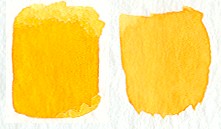 And the same results with gamboge, although I like gamboge as a color. One last thing that I want to point out. Richard Schmid, in his book, asserts that colors harmonize just fine when blended with every other color in a palette. So here are the colors I made by blending every color in my palette with orange.  I have to agree with him. Just having the same "base" color for every mixed color brings out colors that all harmonize with one another. Color wheel be damned. |
|
|
| | | | |
The To-Do List and the To-Don't List |
In some ways, beatcanvas.com is still under construction. For example, the other day, purple fish posted to the graffiti portion of the site, but I hadn't written any notification for myself when that happens, so I just read it today. What's more, purple fish was just trying to email me. As Doug did the other day, but my email address is nowhere on the site. You can't email me... So this weekend, I hope to alleviate those things. And follow up on the "meme tag" suggested to me. With the rain coming down, it could be an interesting weekend. All five kids will be at my place, and it's not a big place, so if it's rainy, things could get cagey. Lots of games help with that. We'll do some painting as well. Since I've been mixing color quite a bit lately, I'll probably do that with Austin and Jacob. That's the To-Do list. The To-Don't List is a phrase I first heard from management guru, Tom Peters. To find more time and more sanity in our lives, sometimes it's smarter to manage our To-Don't list. These would be things that don't really have to be done by us right now, or simply can't be done by us at all. I think the concept dovetails nicely with Stephen Covey's notion of Circle of Concern and Circle of Influence. Covey insists that we're more effective when we exert our energies in those areas where we have influence. But too often, we exert our energies (or mental time) in those areas where we have concern. I'm concerned about homeland security, for example, but aside from writing my legislative representatives and the president, I can do nothing about it - I have no influence beyond my "yop-pish" contribution amidst 275 million Americans, and, in a larger realm, the rest of the world. Little ol' me. I mentioned on Doug's site the other day that I'm news-ed out. In the scope of my Circle of Influence and my Circle of Concern, better and more immediate minds than mine are addressing the problems of the world. I used to know a guy in Corvallis, Oregon (where I once lived), who paid no attention to the national and world news. None whatsoever. I asked him why... "Why work myself up into a dither over things that I can't control when I've got a yard that needs mowing right here?" There's a lot of wisdom in that. There is work that only I can do. Can I call that my Circle of Sole Influence? My kids fall into that. My home. My work that I do for clients. The friendships that I share with people I know. In terms of prioritizing my time, my Circle of Sole Influence gets top billing. Everything else is either on my To-Don't list or it's on the verge of being there. Life is better that way. |
| | | | | |
|
|
|
|
I played Masterword (the BeatCanvas.com word game linked on the left) at lunch today and saw that it was broken by a recent change that I made in it. Zoiks! But I've now fixed that glitch. 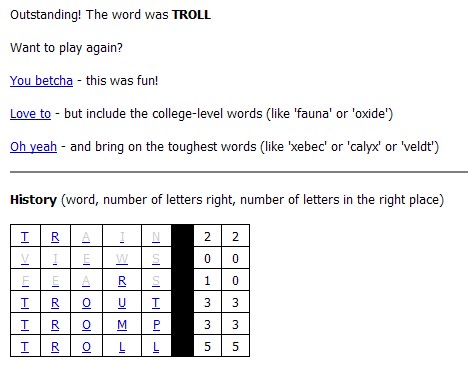 I also know that if you've bookmarked the game page, it saves it in such a way that you play the same word over and over again. I'm working on a fix for that, but in the meantime, the way to get around that is to come straight to the main beatcanvas.com page and click on the game link. That starts a fresh game. |
|
|
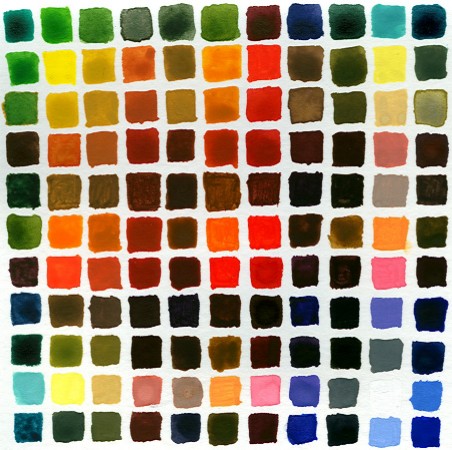 As I mentioned a couple of days ago, after reading Richard Schmid's book on painting, I decided to explore my palette of colors further by mixing each color with each other color and setting the individual swatches side by side. What you see above is that effort. If you start in the upper-left corner and move diagonally to the lower-right corner, that line of swatches is that of the "native" colors, which are: - Viridian (blue-green)
- Cadmium Yellow Pale
- Yellow Ochre
- Burnt Sienna
- Burnt Umber
- Cadmium Orange
- Grumbacher Red
- Violet
- Ivory Black
- Chinese White
- Ultramarine (blue)
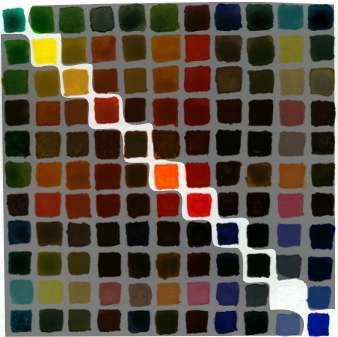 So for each column and row that a native color is found, it has been mixed with every other color and in order. To explain, the 4th row and the 4th column are all colors mixed with Burnt Sienna. The first color mixed would be Viridian, the second Cadmium Yellow Pale, and so on. 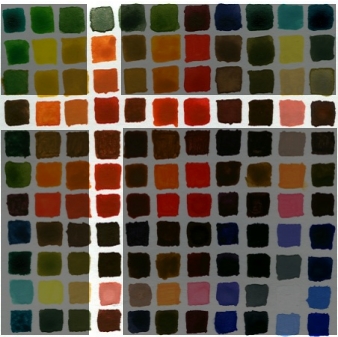 I'm now strongly of the opinion that every painter should do this. I learned a great deal about the strength of some colors, such as red, to easily overpower another color when mixing the two. Color harmony also becomes more obvious by doing this. I noticed that if you take any four adjacent colors, they create a nice harmony. Doesn't matter which colors. Here's an example: 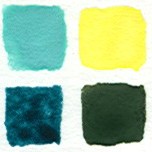 Here you have White/Viridian and White/Cadmium Yellow Pale on the top, and then on the bottom, Blue/Viridian and Blue/Cadmium Yellow Pale. These work together. Here are a few others: 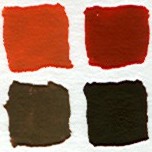 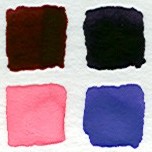 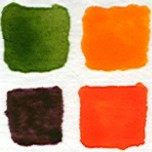 It's because they have colors in common that tie them together. That tie of colors together creates a transition that our eyes can follow. In my first example, I get from White/Viridian to Blue/Cadmium Yellow Pale through White/Cadmium Yellow Pale and Blue/Viridian. Seeing this helped me to understand Schmid's concept of Edges better. An Edge is the transition from one color to another. It can be rapid or slow, steep or shallow. But as long as it is a migration that makes sense in terms of color changes, the eye will accept in a painting. (Further, Edges will define the depth in a painting as much coloration will. I didn't understand Schmid's point about this when I first read it, but I do now. A stark color transition will insist that there is separation between objects. A person standing in front of a building needs no color transition with the building because there are separate. But when painting a face, there can be no harsh absence of transition, or the face will not appear right to us.) If you've ever used Photoshop and Microsoft Paint (or Paintbrush), you know the difference between unrealistic edges and realistic edges. Photoshop will produce gradual transitions to another color, as this zoomed-in movement from orange to white shows: 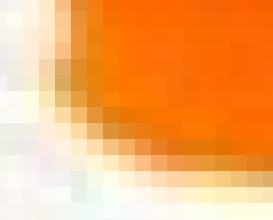 Edges are "smoothed" in Photoshop. Not so in Paint. There you'll see hard edges driven by the pixel. Hence the term, "pixelation." I've found that I really like the series of colors that share a base color. I plan to explore that more. And I want to use this as an occasional guide when reaching for a color... I was surprised by some of the colors created. Cool exercise. |
|
|
 | Meme Tag |  |
Purple Fish has "tagged" me to play a little game of occupations. Here's the deal: Immediately following there is a list of different occupations. You must select at least 5 of them (feel free to select more). You may add more if you like to your list before you pass it on (after you select 5 of the items as it was passed to you). Each one begins with "If I could be..." Of the 5 you selected, you are to finish each phrase with what you would do as a member of that profession. For example, if the selected occupation was "pirate" you might take the phrase "If I could be a pirate..." and add to it "I would sail the 7 Seas, dating lasses from around the worlde." See how easy that is? Here's the list:If I could be a scientist...
If I could be a farmer...
If I could be a musician...
If I could be a doctor...
If I could be a painter...
If I could be a gardener...
If I could be a missionary...
If I could be a chef...
If I could be an architect...
If I could be a linguist...
If I could be a psychologist...
If I could be a librarian...
If I could be an athlete...
If I could be a lawyer...
If I could be an innkeeper...
If I could be a professor...
If I could be a writer...
If I could be a llama-rider...
If I could be a bonnie pirate...
If I could be an astronaut... So, what if...If I could be a gardener... then the world would go hungry. It's unfortunate but true - I lack a gardener's sense. I'm inclined toward organic methods, but I tried that approach at our rural home in southern Iowa when we lived there. 10 acres of land and I didn't have a clue what to do with it or the earth. But while trying, I did learn that peas have pretty white flowers and that pumpkin bread made with true sugar pumpkin kicks the store-bought pumpkin across the yard. Just no comparison. If I could be a llama-rider... then I'd be soon jailed for cruelty to animals. I weigh over 300 pounds. 'Nuff said. If I could be a lawyer... then I would laugh hysterically at silly lawsuits. I was once called for jury duty and the case was for a woman suing Casey's for $250,000 because she slipped and fell on ice in the parking lot during an ice storm. In Iowa. Duh... If I could be a bonnie pirate... then I would steal all the Bonnie's. Or, maybe that suggests that I would be a pretty pirate. Sorry - but "pretty" will never happen for me. So I would get kicked off for being an imposter. If I could be a missionary... um, well, actually, I was once. For a year. Brought four people to Jesus. If I could be a painter... hey, now here's an occupation that I find appealing. Maybe someday I'll be able to make a career change from programmer to painter. That would be very cool. I'll pass this on to some other bloggers... I'll let you know who later. |
|
|
My son, Aaron, has been watching a lot of HALO videos lately. See, people with an XBox can employ a capture card and record their games. Well, he's stumbled onto a very inventive group of videos that morph HALO into a comedy series. The series is called "Red Vs. Blue." And this particular video struck me as very, very funny. It's 14 Mb, but very worth watching. It was created post-election, November 2004. (Just hit "Refresh" if your browser says "Service Unavailable...") ETC: This kind of video emphasizes a point that I should have made yesterday - that people are being creative and distributed in ways not imagined 10 years ago. The creators have taken the existing design/graphics work of others and re-tooled it for their own purposes. Which is no different than sampling in music, but doing this with video games is now called "machinima." As technology allows us, our mastery of a medium, like music or graphics work, will matter less than our ability to have the tools at our disposal (in this case, Adobe Premiere and a capture card) to recreate things to express ourselves in ways that make us look like we are masters. |
|
|
I need to jot something down that I plan to build upon later, but I believe that there are some significant people who've caught the trend and are signaling movement. We need to pay attention. I got my Wired magazine yesterday and in it, frequent smart-guy contributor and author, Daniel Pink, interviews NY Times columnist, Thomas Friedman. Mr. Friedman just released a new book, The World is Flat: A Brief History of the Twenty-First Century. Friedman, who recognizes the trend of globalization, argues that the lifestyle of opulent America is threatened by India and China. In short (and I'm paraphrasing big time), the service industry in America, can be quickly and cheaply exported to these countries. Or other countries. "Leveling the playing field" is the term that Friedman uses; hence, the world is flattening. Geography, distance, and language matter less and less. This isn't about outsourcing. It's about competition. Friedman tells his children, "Finish your homework. People in China are straving for your job." He says this a bit tongue-in-cheek, but the implication is real. Bill Gates, who critiqued Tom's book in a day long personal session, said this: "Twenty years ago, would you rather have been a B-student in Poughkeepsie or a genius in Shanghai? Twenty years ago, you'd rather be a B-student in Poughkeepsie. Today? Not even close. You'd much prefer to be the genius in Shanghai because you can now export your talents anywhere in the world." Now, let's take a high tech worker in a high-dollar residential area in the US who is reading this book and processing it. She says this: There's a working assumption that globalization is overall a good thing. That's not so bad, but it seems that Friedman looks for every opportunity to sell it. He is already trying to make the case that even though outsourcing is moving jobs out of the US at an accelerating pace, it's all gonna be fine:"I firmly believe in the lesson of classical economists about moving work to where it can be done best. ...Work gets done where it can be done most effectively and efficiently. That ultimately helps the New Londons, New Bedfords and New Yorks of this world even more than it helps the Bangalores and Shenzhens. It helps because it frees up people and capital to do different, more sophisticated work, and it helps because it gives an opportunity to produce the end product more cheaply, benefiting customers even as it helps the corporations. ... India's growing economy is creating a demand for many more American goods and services. What goes around comes around." p.20 - 24 She then continues her thinking...Wouldn't that be nice? This is the argument/religion of economics and the argument of the pro-globalization folks. Work should go to the lowest cost producer. That's efficiency. That drives the economy. There are some negatives in these low cost working conditions and for the environment (work goes where environmental regulation is least), but hey?I have an MBA so I know this drill. I like the drill to an extent. But I live here in the US. I was born here and was planning to die here [Ed. - Note the past tense...] But this whole leveling of the international playing field thing could be a problem for us high-living Americans. We are talking about the hollowing out of the American economy here. I live in Mill Valley, California. One of the most expensive places on earth to live. Real estate is astronomical here. Labor costs are about as high as anywhere. There are places in the US that have a cost of living that is half of what it is here. Does my Mill Valley location help me economically? Not as much as it used to when I had a local business. Now I compete with software solutions that are made anywhere not just local consultants who have cost structures similar to mine. Longer term, I may have to consider moving to a place where it won't cost me so much to live so that I will be able to compete with low cost providers. Here's a successful entrepreneur, and she's seriously pondering the question in the long term: where should I live to maintain my lifestyle?Now my question: could it be that housing values, 10 years from now, will deflate in the pursuit to find more affordable housing due to global competition? If we have to compete globally, and we do, then expenses must be trimmed, so it makes sense. Here's a scenario: what happens if the California housing market crashes? What if it happens elsewhere in America? How does that change the retirement plans of boomers at the time that they start retiring? Just wondering out loud... |
|
|
Here's the source for my next painting: 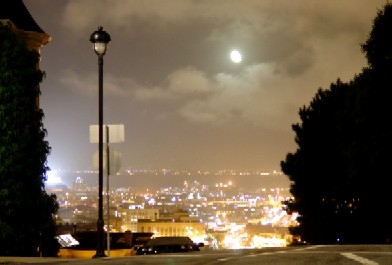 Love the colors. I love nighttime in the city. Such a gorgeous photo. I've been staring at it through the day, strategizing. I've never used liquid frisket, but it's a rubber cement-like substance that you apply on the areas that you want to protect from a watercolor wash. You then lift it later. And I've never tried bright lights, like those you see here, but with my new sense of Schmid's edges, I'm eager to see what I can do. So this painting will bring a few new challenges. I expect that I'll start it at my lunch break on Monday with a value sketch. |
|
|
My next painting is on hold for the moment because I want to try something new - I want to add an element to the picture. I need to get out at night and photograph the element, so in the meantime... I had to take the morning off to drive a friend to the hospital who needed a test done, so while I was in the waiting room, I sketched a bit. I brought this photo with me: 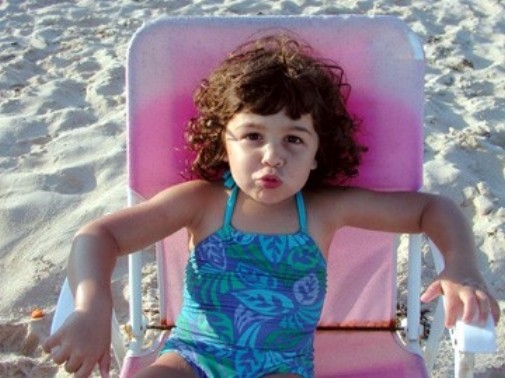 Cute, eh? Here's my waiting room draft: 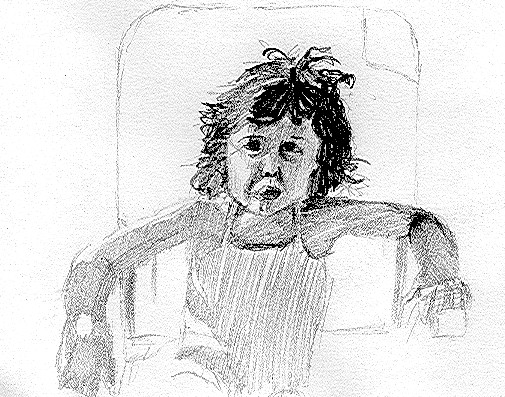 Sketchwork is fine, but I'm eager to get the brushes wet... And my friend's test came out fine, so the day was good. |
|
|
Yesterday while in the waiting room at the hospital, I was near enough to the reception desk to overhear the not-so-quiet discussion that went on among the five ladies of the office. Each woman, in turn and with no exception, dumped on her husband big time. Each would lampoon her man and grouse about him, and the other women would voice their support and outrage and then contribute a story that agreed with their compatriots. Anyone who knows me knows that I'm very unaccepting of male bad behavior. I'm not an apologist for guys at all, but this 30-minute tirade was just ugly. It ended with one woman fantasizing about leaving her guy, and how she would do it. But she wasn't serious about it, and all that I could think of was the office Christmas party, and how these women would show up with their husbands whom they don't love and carry on as though everything were fine. There's no defense for that kind of gossip and backbiting. |
|
|
|
|
I tried painting a Gerbera Daisy over lunch. It kicked my ass. If I would have had time to do the whole flower, it might have been okay, but where I'm thoroughly dissatisfied with myself is in painting the edges - the transitions from one color to another. My edges, with watercolor, are too stark. A flower's petals are smooth and require gentle transitions. Particularly a daisy... its petals are ribbed. I know what I'll be doing tonight after the kids go to bed. By the way, anyone in central Iowa who would like to try their hand at painting or drawing flowers is welcome to join me this Sunday, May 1. It's from 12 - 5 p.m. Per the web site: "We're painting the town red! And every other color of the rainbow at Sunday Sketchers. Join our group for a special visiting artist lecture, then try your own hand at painting, drawing, or sketching your own original piece of art work in our beautiful tropical dome setting. Juried art contest at the conclusion of the day. Cost is $4.00 per person. Bring your own art supplies." I've got extra palettes and watercolor paints. Should be fun :) You know what I look like (<-- see dopey face at left) and I'll be wearing my red shirt. Hope to see you there! (And a special thanks to Stefanie, who brought it to my attention!) |
|
|
In order from left to right, here are my attempts at painting a flower petal today. The actual photo of the petal is on the right.      I got closer as I went, with the last attempt being my first time using Arches paper (love it). But even in the last attempt, my yellow isn't deep enough and my shadows aren't rich enough. More brown - maybe even red. The edges, though, are much better - more realistic transition between colors. To paint edges, I've learned, I need room. All of my paintings thus far have been postcard-sized, roughly speaking. Time to get into the larger canvas. |
|
|
Eating, or, um, the Lack Thereof |
Spurred by several people I know, I'm changing my food habits. First, there was Bella, who did that most heroic thing and actually dropped sugar from her diet. Then there was Laura and Chad. Though neither knows the other, both saw Supersize Me and came away horrified. Chad's been eating well for quite a while (it wasn't triggered by the movie), and frankly, he looks great. And then there is my bike, which is always a motivator. The weather, though a bit rainy, has been cooperating somewhat to allow me to bike to work half the week, and I expect soon it will be daily again. So I need to change my eating habits... During the day, I am a paragon of great eating. Typically, either fresh juice from my juicer or some sort of store-bought juice, like grape juice, sometimes occasioned by a wheat bagel with peanut butter or by unsalted trail mix. Lunch is usually fresh salad from the salad bar downstairs. And water to drink during the day, although in the past two months I was really in a raspberry Snapple mood - but no longer. Then comes dinner and afterward, and this is usually where I collapse. I overeat at night. And it's not necessarily bad food; it's just too much food. And at night, which is the worst. The bike helps with this. If I go for late night bike rides, I tend not to indulge myself. So I expect a summer of losing weight. I'm working on it, anyway. But to see others I know, including a good friend fo mine who posted in Graffiti about this, get serious about it helps keep me focused. |
|
|
The Absolute Coolest Sketch Box |
Check this out:  Boy, someone was thinking... that's awesome. Click on the picture to check it out. |
|
|
| | | | |
The song by The Cure, Friday I'm in Love, is what I wake up to each day. I don't care if Monday's blue
Tuesday's gray and Wednesday too... Followed by Phil Collins' Son of Man (from Tarzan) and then by Me and Julio Down by the Schoolyard. With that playlist as my alarm clock, every day is fabulous :)Today was a particularly good day. If you recall the search engine that I was building for work, today was the day that we indexed the files for the beta site. Most awesome. My body is responding to the daily bike ride to and from work. The great thing about muscles is that they remember and come back quickly. God blessed me with very strong legs, so my legs are singing on the ride. I hope that I'm able to ride a bike until the day I die. It's the best. Picked up the boys from school and we went to a local game spot and got a SpongeBob game for the XBox. Then to Barnes & Noble where Austin loves to listen to music. Jacob and I played tug of Dad while Austin was jamming out. And then we all went upsatirs upstairs for Jacob to play with the Thomas train set. I picked up Red Scarf Girl, which was mentioned by Kris recently. And then home. I got home to find that red fish mentioned another painter's site. Duane Keiser paints a postcard-sized painting each day and then sells it for $100. He does very nice work, and he sells the work. Which leads to a question I've asked myself lately: what am I doing with my art? I'm new to painting, but I know that I can paint (see my gallery if you're unfamiliar with my work). At the moment, I'm in a period of wax on/wax off. I'm trying a lot of things and reading a lot to get an education in art that I never received. But once I'm done with that, yes, I intend to sell my work. So how will I sell it? Most likely through PayPal. They take credit cards now and you don't need to sign up for PayPal to use the service. Works for me. In the past, I've had Internet merchant accounts for software that I sold through my business web site. I think the PayPal method will work just as well for this. About 1/4 of the books in my library here at home are business-y books. And about half of those are marketing. I broke out Thinkertoys yesterday to begin re-reading that. One concept is the Idea Box. The blueprint for the concept is to: - Specify the challenge (selling my art)
- Identify the parameters that determine the success of the challenge (such as the quality of my work, the media I use to generate buzz, the price point, and the distance I have from the buyer - more about this in a minute, etc)
- List the variations
- Finally, try different combinations
It's something like scenario planning, where you pick scenarios to posit different problems and then see which approaches most uniformally provide a resolution.So what appeals to me? As Bella might say, how do I best follow my bliss? The quality of my work is driven by the time I put into it. With my five kids, three of whom live with me, and other factors, I can probably put out a larger painting once a week. Or I can go for smaller work and finish it in about 1 to 3 days. I don't want to scrimp on the quality though for volume's sake. I need to like it before I expect anyone else to like it... The media to generate buzz - when I'm ready, I'd like to crack open my guerilla marketing books and see what I can do. Certainly having a blog helps because I can be googled or yahoo'd. (I'm currently the number #1 hit on Yahoo for "watercolor painting blog," for example.) But I can't rely only on good search engine placement. "If I build it, they will come" is an Internet myth that popped 4 years ago. So the buzz will have to come from elsewhere, in addition to blogs (and thank you to those who link to me :) Price point... this is tough for me. I don't like $100 art. It's out of the reach of the average person. I mean no disrespect to Duane or others who do this, but I have a hard time limiting good art to just a few. (It ain't my bliss, although if that's the better way, I can be educated if it's the difference between success and no success.) What I would like to see is for people to be able to get prints of my work for around $20. Anyone can afford $20. But at that price, I need volume, and I'll also need a large gallery of work. So I don't know about price point... you have an opinion you'd like to share? And then there is the distance I have from the buyer - or, how personal is the art? Do I just paint whatever I feel like painting, or do I paint by request, as some artists do? I suppose if a commission came in, I'd take it as a good challenge and get right to it. So, I have some questions in front of me, variations to consider, and some labor in marketing in addition to building up a gallery of work. I love all of this. I'll leave you with a haiku by Evelyn Lang: perfect summer sky -
one blue crayon
missing from the box |
| | | | | |
|
|
|
|
|
|
|